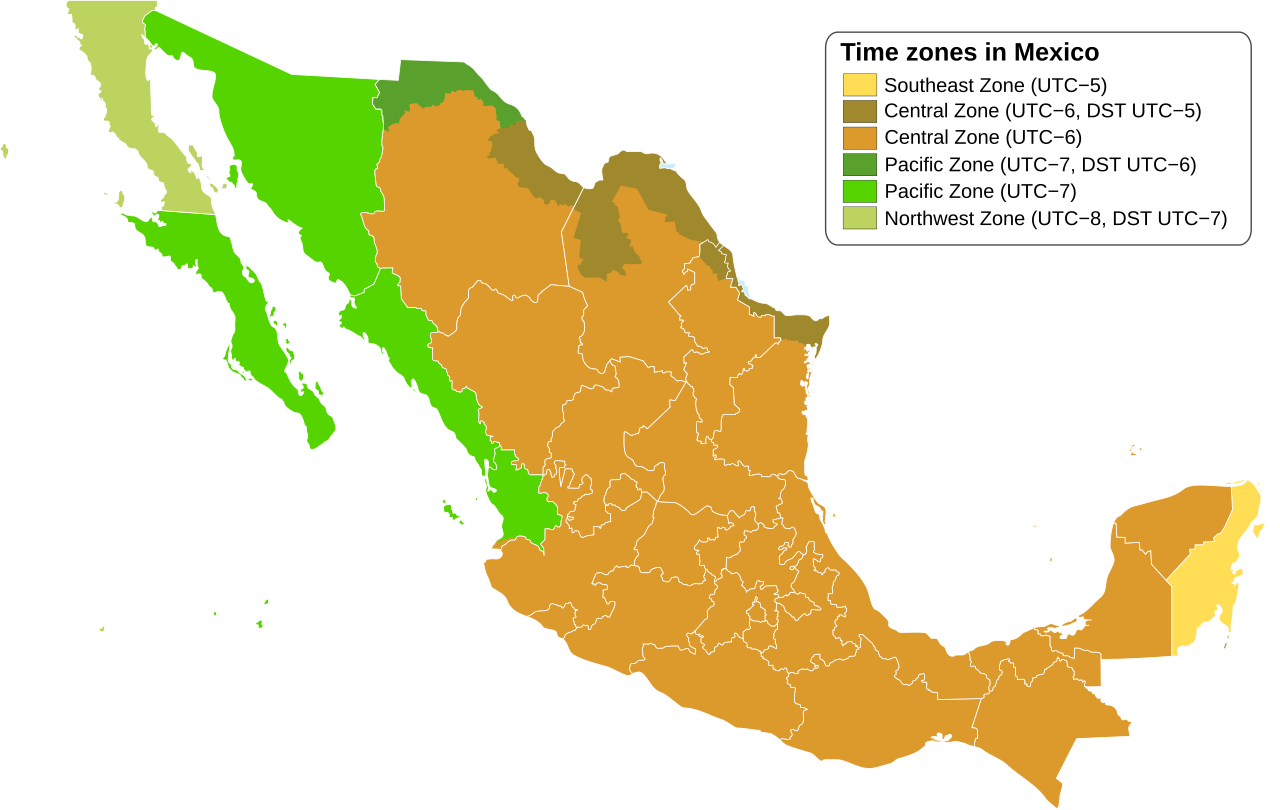Mexico Current Time & Time Zone Map & Time Zone
Live time zones for all Mexican states and territories

Northwest Zone Time
UTC-7:00 (PDT)
16:39:46
Sunday, October 19, 2025
Example city: Tijuana
Pacific Zone Time
UTC−07:00 (PT, year round)
16:39:46
Sunday, October 19, 2025
Example city: Hermosillo
Central Zone Time
UTC−06:00 (CST, year round)
18:39:46
Sunday, October 19, 2025
Example city: Mexico City
Southeast Zone Time
UTC−05:00 (EST, year round)
18:39:46
Sunday, October 19, 2025
Example city: Cancún
1. How Many Time Zones Does Mexico Have?
Mexico uses 4 time zones: Northwest (UTC−08:00/UTC−07:00 in Baja California), Pacific (UTC−07:00, e.g., Sonora – year round), Central (UTC−06:00 – most of the country, generally year round), and Southeast (UTC−05:00 – Quintana Roo, year round).
2. Mexico Time Zones (Map Reference)
Northwest Zone (UTC−08:00/UTC−07:00)
Baja California (e.g., Tijuana). Follows the U.S. DST schedule.
Pacific Zone (UTC−07:00)
Sonora and some Pacific states/areas (e.g., Hermosillo). No DST (year round).
Central Zone (UTC−06:00)
Most of Mexico including Mexico City. Generally no DST since 2022, except certain municipalities along the northern border that align with the U.S. schedule.
Southeast Zone (UTC−05:00)
Quintana Roo (e.g., Cancún). No DST (year round).
3. Daylight Saving Time schedule (Mexico)
Since 2022 most of Mexico does not observe DST. Exceptions include Baja California and some northern border municipalities which follow the U.S. schedule: begins the second Sunday in March at 2:00 a.m., ends the first Sunday in November at 2:00 a.m. local time.
4. History of Mexico Time Zones
Mexico historically used DST nationwide, but a federal reform in 2022 eliminated DST for most of the country, retaining it only in Baja California and selected municipalities along the U.S. border to facilitate cross‑border coordination.
5. Learn More About Mexico Time Zones
Mexico Current Time & Time Zone Map & Time Zone
Live time zones for all Mexican states and territories

Northwest Zone Time
UTC-7:00 (PDT)
16:39:46
Sunday, October 19, 2025
Example city: Tijuana
Pacific Zone Time
UTC−07:00 (PT, year round)
16:39:46
Sunday, October 19, 2025
Example city: Hermosillo
Central Zone Time
UTC−06:00 (CST, year round)
18:39:46
Sunday, October 19, 2025
Example city: Mexico City
Southeast Zone Time
UTC−05:00 (EST, year round)
18:39:46
Sunday, October 19, 2025
Example city: Cancún
1. How Many Time Zones Does Mexico Have?
Mexico uses 4 time zones: Northwest (UTC−08:00/UTC−07:00), Pacific (UTC−07:00, no DST in Sonora), Central (UTC−06:00), and Southeast (UTC−05:00).
2. Mexico Time Zones (Map Reference)
Northwest Zone (UTC−08:00/UTC−07:00)
Baja California (e.g., Tijuana). Follows the U.S. DST schedule.
Pacific Zone (UTC−07:00)
Sonora/Hermosillo. No DST (year round).
Central Zone (UTC−06:00)
Most of Mexico including Mexico City. Generally no DST since 2022, with exceptions on the northern border.
Southeast Zone (UTC−05:00)
Quintana Roo / Cancún. No DST (year round).
3. Daylight Saving Time schedule (Mexico)
Most of Mexico does not observe DST since 2022. Baja California and some northern border municipalities follow the U.S. schedule: second Sunday in March to first Sunday in November.
4. History of Mexico Time Zones
The 2022 reform eliminated DST nationwide except for border areas aligned with the U.S.; prior to that, DST was widely used with dates harmonized with the U.S. since 2007.